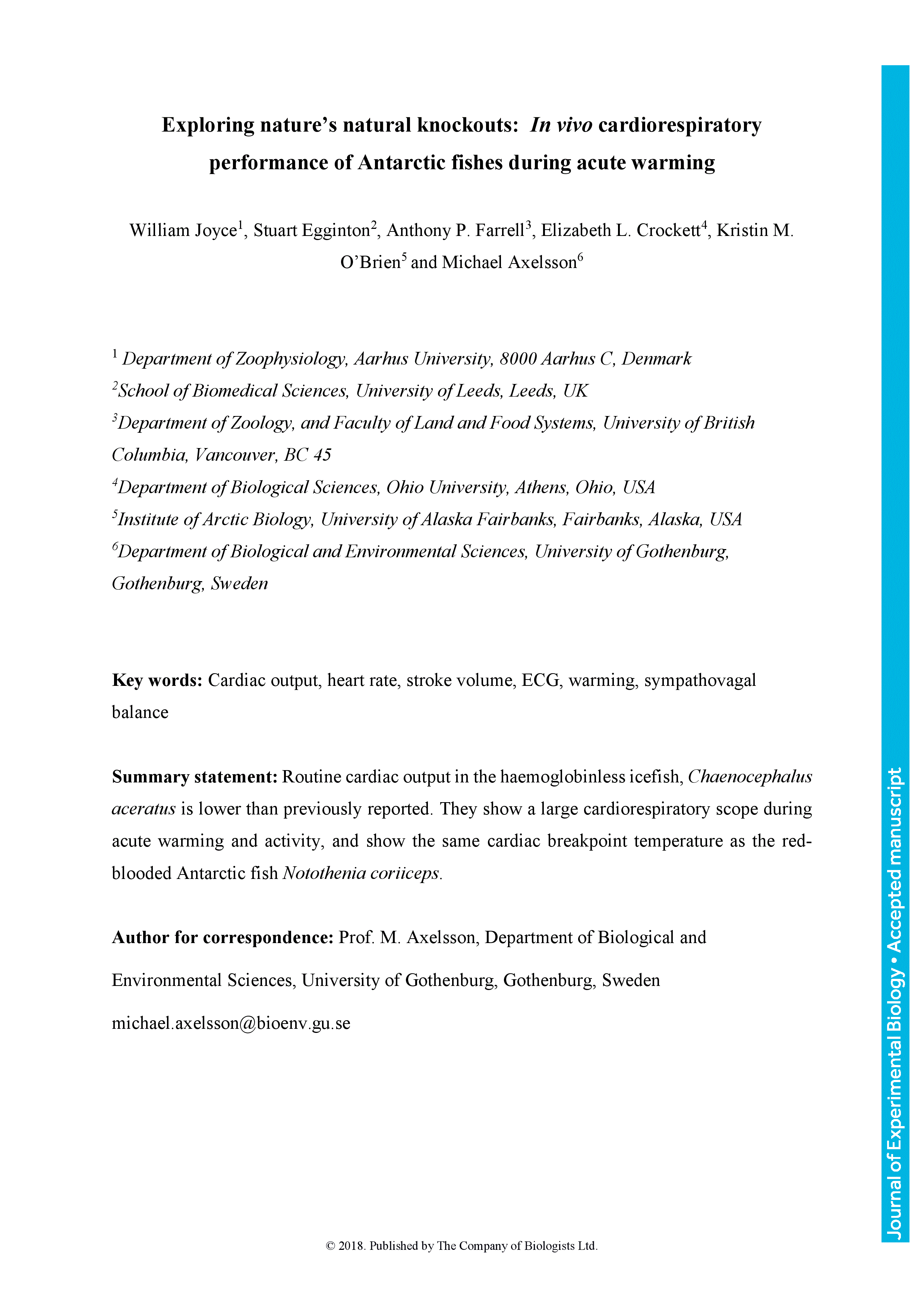We tested the hypothesis that Blackfin icefish (Chaenocephalus aceratus), one of the six species in the family Channichthyidae (the icefishes) that do not express haemoglobin and myoglobin, lack regulatory cardiovascular flexibility during acute warming and activity. The experimental protocols were designed to optimize the surgical protocol and minimize stress. First, minimally invasive heart rate (fH) measurements were made during a thermal ramp until cardiac failure in C. aceratus and compared with the closely related red-blooded Black rockcod (Notothenia coriiceps). Then, integrative cardiovascular adjustments were more extensively studied using flow probes and intravascular catheters in C. aceratus during acute warming (from 0 to 8°C) at rest and after imposed activity. C. aceratus had a lower routine fH than N. coriiceps (9 min−1 vs. 14 min−1) and a lower peak fH during acute warming (38 min−1 vs. 55 min−1) with a similar cardiac breakpoint temperature (13 and 14°C, respectively). Routine cardiac output (Q̇) for C. aceratus at ∼0°C was much lower (26.6 ml min−1 kg−1) than previously reported, likely because fish in the present study had a low fH (12 min−1) indicative of a high routine vagal tone and low stress. C. aceratus increased oxygen consumption during acute warming and with activity. Correspondingly, Q̇ increased considerably (maximally 86.3 ml min−1 kg−1), as did vascular conductance (five-fold). Thus, unlike earlier suggestions, these data provide convincing evidence that icefish can mount a well-developed cardiovascular regulation of heart rate, cardiac output and vascular conductance, and this regulatory capacity provides flexibility during acute warming.
Exploring nature's natural knockouts: In vivo cardiorespiratory performance of Antarctic fishes during acute warming
Currently Viewing Accepted Manuscript - Newer Version Available
William Joyce, Stuart Egginton, Anthony P. Farrell, Elizabeth L. Crockett, Kristin M. O'Brien, Michael Axelsson; Exploring nature's natural knockouts: In vivo cardiorespiratory performance of Antarctic fishes during acute warming. J Exp Biol 2018; jeb.183160. doi: https://doi.org/10.1242/jeb.183160
Download citation file:
Advertisement
2023 JEB Outstanding Paper Prize shortlist and winner

The JEB Editors are delighted to announce the shortlisted authors for the 2023 JEB Outstanding Paper Prize. Read the winning paper - Tiny spies: mosquito antennae are sensitive sensors for eavesdropping on frog calls - by Hoover Pantoja-Sanchez and Brian Leavell from Ximena Bernal's lab at Purdue University, USA.
JEB Science Communication Workshop for ECRs

If you’re an early-career researcher interested in science communication and are attending the SEB Annual Conference in Prague this summer, come a day early and join the JEB Editors at a sci comm workshop to learn the key writing skills needed to promote your research to a broad audience beyond your peers (1 July at 14.30-17.30). Places are limited to 24 attendees, and applicants should apply through the SEB registration page by 30 April 2024.
Bridging the gap between controlled conditions and natural habitats in understanding behaviour

Novel technologies enable behavioural experiments with non-model species, in naturalistic habitats and with underexplored behaviours. In their Commentary, Scholz and colleagues discuss how to obtain a deeper understanding of the natural ecology and lifestyle of study animals.
Beluga metabolic measures could help save species

To help save animals from extinction, it’s important to understand what each species needs to survive. This led Jason John et al. to measure the metabolic rates of captive belugas to develop a ‘fish calculator’ showing that the whales need to eat ~23 salmon per day.
ECR Workshop on Positive Peer Review

Are you an ECR looking for tips on how to write concise, astute and useful manuscript reviews? If so, join the JEB Editors at a 2-hour JEB-sponsored Workshop on Positive Peer Review at the Canadian Society of Zoologists annual meeting in Moncton on 9 May 2024 at 13.00-15.00. There are 25 spaces for ECRs and selection is first come, first serve. To sign up, check the ECR Workshop box when you register for the CSZ meeting.



